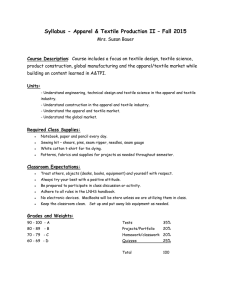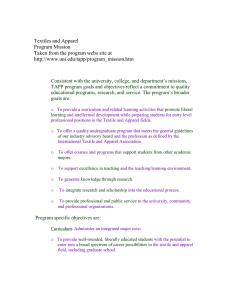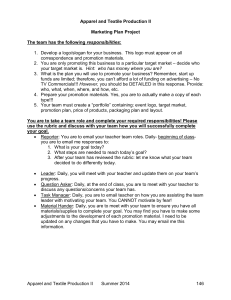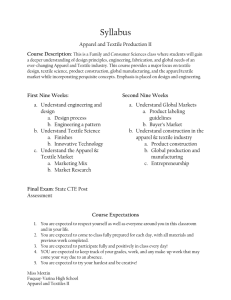Document 13136075
advertisement
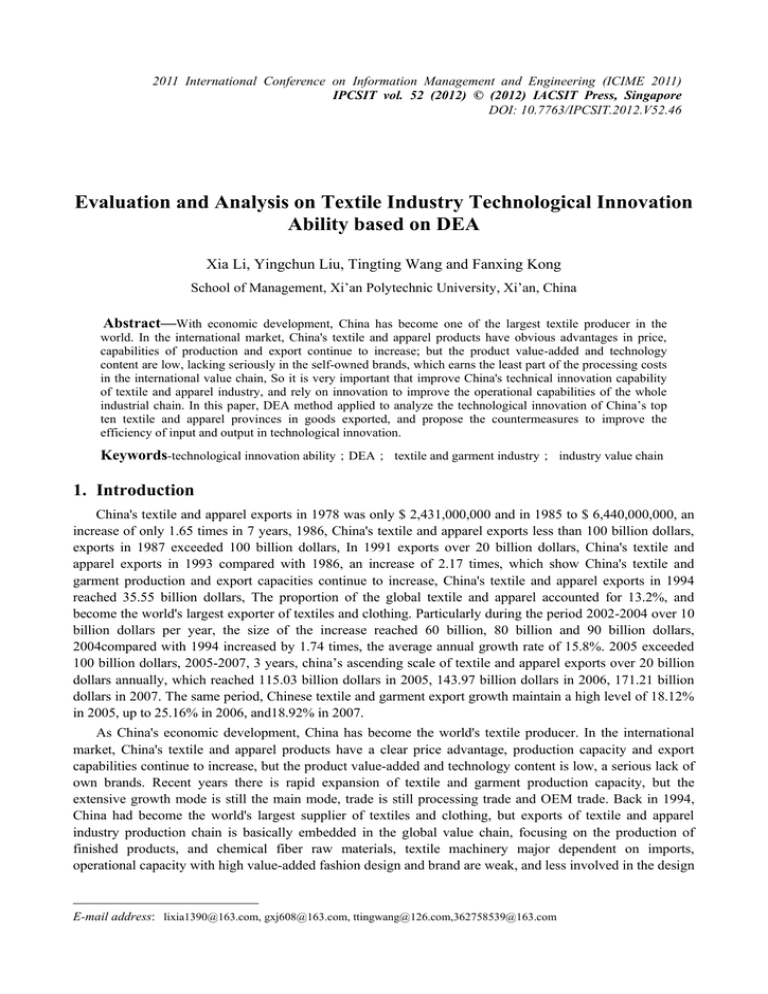
2011 International Conference on Information Management and Engineering (ICIME 2011) IPCSIT vol. 52 (2012) © (2012) IACSIT Press, Singapore DOI: 10.7763/IPCSIT.2012.V52.46 Evaluation and Analysis on Textile Industry Technological Innovation Ability based on DEA Xia Li, Yingchun Liu, Tingting Wang and Fanxing Kong School of Management, Xi’an Polytechnic University, Xi’an, China Abstract—With economic development, China has become one of the largest textile producer in the world. In the international market, China's textile and apparel products have obvious advantages in price, capabilities of production and export continue to increase; but the product value-added and technology content are low, lacking seriously in the self-owned brands, which earns the least part of the processing costs in the international value chain, So it is very important that improve China's technical innovation capability of textile and apparel industry, and rely on innovation to improve the operational capabilities of the whole industrial chain. In this paper, DEA method applied to analyze the technological innovation of China’s top ten textile and apparel provinces in goods exported, and propose the countermeasures to improve the efficiency of input and output in technological innovation. Keywords-technological innovation ability;DEA; textile and garment industry; industry value chain 1. Introduction China's textile and apparel exports in 1978 was only $ 2,431,000,000 and in 1985 to $ 6,440,000,000, an increase of only 1.65 times in 7 years, 1986, China's textile and apparel exports less than 100 billion dollars, exports in 1987 exceeded 100 billion dollars, In 1991 exports over 20 billion dollars, China's textile and apparel exports in 1993 compared with 1986, an increase of 2.17 times, which show China's textile and garment production and export capacities continue to increase, China's textile and apparel exports in 1994 reached 35.55 billion dollars, The proportion of the global textile and apparel accounted for 13.2%, and become the world's largest exporter of textiles and clothing. Particularly during the period 2002-2004 over 10 billion dollars per year, the size of the increase reached 60 billion, 80 billion and 90 billion dollars, 2004compared with 1994 increased by 1.74 times, the average annual growth rate of 15.8%. 2005 exceeded 100 billion dollars, 2005-2007, 3 years, china’s ascending scale of textile and apparel exports over 20 billion dollars annually, which reached 115.03 billion dollars in 2005, 143.97 billion dollars in 2006, 171.21 billion dollars in 2007. The same period, Chinese textile and garment export growth maintain a high level of 18.12% in 2005, up to 25.16% in 2006, and18.92% in 2007. As China's economic development, China has become the world's textile producer. In the international market, China's textile and apparel products have a clear price advantage, production capacity and export capabilities continue to increase, but the product value-added and technology content is low, a serious lack of own brands. Recent years there is rapid expansion of textile and garment production capacity, but the extensive growth mode is still the main mode, trade is still processing trade and OEM trade. Back in 1994, China had become the world's largest supplier of textiles and clothing, but exports of textile and apparel industry production chain is basically embedded in the global value chain, focusing on the production of finished products, and chemical fiber raw materials, textile machinery major dependent on imports, operational capacity with high value-added fashion design and brand are weak, and less involved in the design E-mail address: lixia1390@163.com, gxj608@163.com, ttingwang@126.com,362758539@163.com and marketing areas with higher profit. This division status, determine the profitability of most textile enterprises’ profit will not exceed 5% and apparel business is difficult to over 10%. The research of modern Industrial value chain shows that the profit chain presents a "V" shape, in this curve, the two tilt is the R&D and marketing of high value-added, industry profit margins of 20% to 25%; intermediate droop is the production of low value-added, profit margin is only 5%. In the international labor division of textile and garment industry, China's enterprises in the smile curve exactly the most low-end, earning at least that part of the production is the processing fee, to be known as the public opinion and experts and scholars in the international industrial chain, "International migrant workers. " Today, the competitive advantage is not only products, but the whole industry chain. To enhance the competitiveness of the industrial chain, china's textile and garment industry must work hard and improve the operational capabilities of the whole industry chain, must rely on innovation, improve the technical innovation of textile and garment industry. 2. Method and Model DEA is more effective and convenient way in the existing models of efficiency evaluation to solve the timing problem of multiple input and output. It is proposed by well-known operations researchers, Charnes, Cooper and Rhodes, from the United States in 1978, which is a decision-making method, to analyze relative efficiency about DMU which all kinds of multiple inputs and multiple outputs. This model CCR as the evaluation method selected, the relevant model is as follows: Min n j x j s x j0 j1 n s.t. j y j s y j0 j 1 0; j 1,2, ,n; s - 0; s 0 j T x x1 j , x2 j ,, xmj y y1 j , y2 j ,, y sj j 1,2, , n where, is the competitiveness evaluation index, j and j , j n m s mean vector of_ decision making units with inputs and outputs, are the parameters to be estimated, s , s are the slack variables. Use DEA evaluate the ability of technological innovation of the textile and garment cities, provinces and municipalities as each DMU , obtain results of the effectiveness of technological innovation about textile cities solved by linear programming. T According the value of , s , s to divide the decision-making unit is into three categories: (1) 0 1 and s0 s0 0 , so DMU 0 is called DEA effective, that the decision-making unit DMU 0 on the basis of the original investment x0 has maximum output, resources can be fully utilized. (2) 0 1 and s 0 0 ( s 0 0 ), so DMU 0 is called DEA weakly effective, that as the decision-making unit DMU 0 , input x0 can be reduced s0 while maintaining the same outputs y 0 ; or in the case of constant input x0 , output can be increased s0 . (3) 0 1 , DMU 0 is called DEA non-effective, in other words, for decision-making unit DMU 0 , inputs x0 can be reduced to the ratio 0 of original through a combination of inputs while maintaining the original outputs y 0 not-reduced. Select the year 2009 the amount of textile and apparel exports as the top 10 provinces and cities as decision-making units in Table 1, to analyze evaluation of technical innovation. TABLE I. PROVINCIAL STATISTICS OF CHINA'S EXPORT VALUE OF TEXTILE AND APPAREL IN JANUARY-DECEMBER 2009 Data Source: China Textile Industry Association Rank Province Name Export value (billion dollars) Growth Rate 1(DMU1) Zhe Jiang(ZJ) 39.76919 -5.90% 2(DMU2) Guang Dong(GD) 30.99162 -9.19% 3(DMU3) Jiang Su(JS) 26.72338 -8.53% 4(DMU4) Shang Hai(SH) 15.29429 -7.96% 5(DMU5) Shan Dong(SD) 14.20456 -8.65% 6(DMU6) Fu Jian(FJ) 9.46270 18.62% 7(DMU7) Xin Jiang(SJ) 4.96153 -53.68% 8(DMU8) Liao Ning(LJ) 3.76723 -1.08% 9(DMU9) He Bei(HB) 2.92943 7.80% 10(DMU10) Si Chuang(SC) 2.34025 10.26% 3. Evaluation Index System of Technological Innovation Different scholars and experts on the technological innovation capability definition is different, foreign scholars Seven Maller consider that technological innovation is the integrated embodiment of product development, improving production technology, reserves, production, and organizational capacity, technological innovation is showed by the R&D capabilities, production preparation, marketing capability, management capability and contains more extensive content, so setting up the technological innovation ability evaluation system is a more complex process, indicators should be representative, integrity and systematic, specially comprehensive should be highlighted; in the choice of specific indicators must be given to common indicators of content among all types of enterprises, the same statistical methods, in order to facilitate comparison, the selection of indicators to consider the to quantification of indicators and the ease and reliability of data collection, make the best use of available statistics and the normative standards , which will help to grasp and operate. This paper fully considered the characteristics of the textile and garment industry to meet requirements of the mathematical model and references to technological innovation ability evaluation index system of the domestic and foreign experts and scholars, from the perspective of input and output, design evaluation index system as following: TABLE II. TECHNOLOGICAL INNOVATION ABILITY EVALUATION INDEX SYSTEM OF TEXTILE AND GARMENT INDUSTRY The total funding for technological Input Indicators Innovation Input innovation(million yuan) R&D Funds(million yuan) The proportion of scientific and technical personnel (%) Innovation Input Patents with service The proportion of international advanced level equipment (%) Product Marketing Product marketing costs (million yuan) Input Indicators Quantity of innovative investment funds Quantity of R & D Funds Total number of science and technology personnel / total number of employees Number of patents with service Number of international advanced level equipment / device number Total investment cost of product marketing Output Indicators TABLE III. Capability The proportion of product marketing personnel (%) Number of Product marketing personnel / total number of employees Innovation Output New product return rate (%) New Net income / total revenue sales Market share of new products (%) New product sales / total sales of the commodity market VALUES OF TECHNOLOGICAL INNOVATION ABILITY EVALUATION INDEX IN TEXTILE AND APPAREL INDUSTRY Output Indicator Input Indicators Indicators s City ZJ GD JS SH SD FJ XJ LN HB SC X1 X2 X3 X4 X5 X6 X7 Y1 Y2 959.227 888.431 923.468 431.426 890.123 974.621 723.143 9017.806 789.432 680.038 599.517 511.138 477.751 169.425 442.877 576.892 347.805 425.767 389.955 202.733 4.4 4.1 4.0 3.9 3.5 3.3 3.4 3.2 2.8 2.6 21.0 19.0 16.0 16.0 14.0 11.0 10.0 12.0 10.0 11.0 37.3 35.5 34.3 32.1 31.9 30.2 25.9 27.8 25.1 26.1 4383.125 3927.467 4311.453 3677.018 4215.604 4621.567 3003.451 3241.566 3677.894 4467.790 23.3 24.6 22.3 21.8 22.5 21.9 19.7 20.0 19.8 21.3 18.0 16.6 17.0 18.0 16.4 19.3 16.0 16.2 18.2 17.3 26.7 22.3 22.1 24.7 23.5 25.9 19.3 18.9 23.5 20.2 Note: The Evaluation System used all the data from the 2009 "China Science and Technology Statistical Yearbook", "Statistical Yearbook of the textile industry", and according the Chinese Bureau of Statistics website, the China Textile Economic Information Network, the State Council Development Research Center of Information Network and State Intellectual Property Office released data processing to organize and access. 4. Calculation and Analysis Start MyDEA software, load the data shown in Table 3, select the CCR-I analysis (output unchanged, input smallest), running evaluation results are shown in Table 4. The output shows that: the effective number DMU10 for the DEA; and DMU9, DMU7, DMU6 and DMU4 is weak DEA efficient; and DMU1, DMU2, DMU3, DMU5, DMU8 non-effective for the DEA. TABLE IV. DMU S1 - S2 - S3 - THE RESULTS OUTPUT S4 - S5 - S6 - S7 - S1 + S2 + Efficiency value V 1 50012 41274 0.00 4.40 0.04 58060 0.01 0 0 0.97 2 30393 24641 0.00 2.29 0.01 0.01 0 0 0.85 3 2921 3250 0.01 3.97 0.05 14373 0.00 0 0 0.84 4 43142 16942 0.04 16.00 0.32 367701 0.22 0 0 1.00 0 0.89 5 0 314 0 0.00 2.34 0.03 4852 0.00 0.02 6 12796 16175 0.00 0.00 0.02 79683 0.00 0 0 1.00 7 72314 34780 0.03 10.00 0.26 300345 0.20 0 0 1.00 8 829351 24916 0.00 0.00 0.03 28002 0.03 0 0 0.96 9 78943 38995 0.03 10.00 0.25 367789 0.20 0 0 1.00 0 0 1.00 10 0 0.00 0.00 0.00 0.00 0.00 0.00 5. Conclusion China's technological innovation of textile and apparel is uneven in the ten provinces and cities above, which is due to the integrated efficiency of textile and garment industry is different all over the country, from the angle of effectiveness input-output to analyze, many areas affected by the level of technique, environment, management and other effects, can’t get corresponding desired output when invested, there are some room for growth. There is weak DEA efficient and non-effective in China's technological innovation capability of textile and garment industry, and the main factors is: (1) low level of technology and R & D capabilities, most companies do not have their own R & D Centre,and lack of strong awareness linking with the research institutes, universities and other research institutions, so that the enterprise is not only lack of internal sources of technology but also lack of external technology sources. (2) The relatively outdated technical equipment, large-scale textile and garment equipment rely on import basically. Currently, the textile industry is still a labor-intensive industry in China, there are a large number of SMEs, to these enterprises, there is huge sunk cost when they eliminate the relatively outdated equipment, most of them can not afford. (3) Marketing information is relatively outdated areas, there are a lot of inputs of product marketing costs, poor ability to respond to the market, unable to respond rapidly to adapt to the complex and volatile market environment. For the problems in technology innovation of China's textile and garment industry, proposed recommendation to increase the ability of competitiveness and innovation, and make input and output reasonably and effectively. (1) Follow the road of combining Production, learning and research, take full advantage of internal and external resources for enterprise development for support. (2) Encourage enterprises’ development to the Scale and the Group, speed up the pace of industry concentration, increase their scale effect, form industry cluster advantages, further change industrial structure, form the regional characteristics economy. (3) Attention to personnel training, make the design and marketing become a pillar, rather than manufacturing, OEM and sample processing. 6. References [1] Kairong Wang, Guangye Xu, New Methods Identifying and Ranking Weakly Efficient DMUs in DEA. Journal of Beijing Technology and Business University(Natural Science Edition), Vol 27, no. 1, pp.75-78, 2009 (In Chinese). [2] Minglang Huang, and Zhe Zhen, Evaluation and Analysis on technological innovation ability of Textile and garment industry. Economic Forum pp. 49-51, 2008 (In Chinese). [3] Dongsheng Ni, Application of Data Envelopment Analysis Method in Study on China’s Regional Technological Innovation Capability. Technology Economics, Vol 27, no. 8, pp. 22-28, 2008 (In Chinese). [4] Liping Wang and Naijing Wang, Comparative Study on Technology Innovation Ability of Shandong, Technology Economics, Vol 27, no. 3, pp. 56-60, 2008 (In Chinese). [5] K G R Jahanshahloo, Elissa, H V Junior and F H Lotfi, “A new DEA ranking system based on changing the reference set, ” European Journal of Operration Research no. 181, pp. 331-337, 2007. [6] Amirteimoori A, “Efficient and anti-efficient frontier,” Mathematics and Computation, no.186, pp. 10-16, 2007. [7] Shouwei Li, The DEA Method and Empirical Research For Technological Innovation Capability. Science & Technology Progress and Policy, Vol 27, no.1, pp. 119-124, 2010 (In Chinese). [8] R G COOPER, “An empirically derived new product selection model,” IEEE Transaction On Engineering Management, vol 28, pp. 54-61, 1981.




